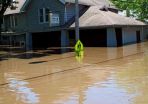During the 20th century, a network of dams and riverbank stabilization structures was built to control and manage the flow of water in the Missouri River for a variety of purposes, including flood control, water supply, and navigation. In addition to these many benefits, the projects also significantly reduced the amount of sediment traveling down the river to the Mississippi River and ultimately out to the Gulf of Mexico. These engineering projects and the resulting changes in the river's natural habitat contributed to declines of one fish species, the pallid sturgeon, and two bird species, the least tern and piping plover, which are all listed as threatened or endangered. Currently, most river management authority lies with the Corps, essentially delegating it as the "water master" and hence sediment manager of the Missouri River.
In the early 2000s, to address the adverse consequences of river development on the endangered species and comply with U.S. Fish and Wildlife Service "biological opinions," the Corps began projects to restore sandbar and shallow water habitats along the lower river. However, these projects drew concern that the sediment being discharged into the river at these project sites was impacting water quality and violating pollution control laws. Moreover, opponents said that the additional sediment and associated nutrients, especially phosphorus, were increasing the size of the dead zone in the Gulf. In light of these concerns, the Corps asked the Research Council to examine sediment and related resource management in the Missouri River system.
The committee that wrote the report found that sediment concentration and deposition are as important as the quantity and flow of water for many river processes. Current means for collecting and evaluating sediment data, however, are fragmented and not well-organized. A centralized system for evaluating, archiving, and retrieving Missouri River sediment is necessary for better informed river and sediment management decisions. The committee recommended that the Corps and U.S. Geological Survey extend their ongoing collaborative efforts in sediment data collection and evaluation and develop a "sediment budget" for the whole river, which would include provisions for continuing revisions and updates as new data become available.
To date, the Corps' restoration projects have been implemented and monitored with limited strategic guidance. To move toward a more systematic approach to ecosystem management, the report proposes actions for evaluating current and future projects. These include the establishment of ecological performance objectives and the development of conceptual models to evaluate environmental variables and their relative influences on endangered species. Additionally, given that the restoration projects may not be effective in removing the species from the threatened and endangered list, alternative actions for species' recovery should be formulated.
The report also examined other options to reintroduce additional sediment into the Missouri River, which include removing riverbank stabilization structures, dredging, bypassing sediment around dams in the main stem of the river, removing dams, and increasing sediment from tributaries. The committee noted that all such alternatives would face major technical and financial constraints and that a majority of Missouri River valley residents would be unlikely to support major reconfiguration of the river channel. The Corps' restoration projects could release enough sediment to increase supply to the Mississippi delta by 10 percent to 20 percent, roughly 34 million tons per year, for at least the next 15 years. However, there is little potential in the near future to re-establish volumes of sediment transported downstream that approach the amounts before construction of dams and stabilization structures, the report concludes.
Regarding the influence of the Corps' restoration projects on the Gulf dead zone, the committee said that multiple factors affect the size of the zone, and it is inappropriate to relate dead zone changes in any given year to these projects. Further, given the relatively small volumes of sediment and nutrients added to the Missouri River from the Corps' projects, they are not likely to significantly change the size of the northern Gulf of Mexico dead zone.
When developing water quality standards, the large amounts of sediment and nutrients carried in the river before the dams and structures were engineered should be considered, the report says. In addition, all actions by the Corps that discharge sediment in the Missouri River, either during project construction or through subsequent erosion, should be monitored to ensure they comply with water quality criteria.
###
The report was sponsored by the U.S. Army Corps of Engineers. The National Academy of Sciences, National Academy of Engineering, Institute of Medicine, and National Research Council make up the National Academies. They are independent, nonprofit institutions that provide science, technology, and health policy advice under an 1863 congressional charter. Committee members, who serve pro bono as volunteers, are chosen by the Academies for each study based on their expertise and experience and must satisfy the Academies' conflict-of-interest standards. The resulting consensus reports undergo external peer review before completion. For more information, visit http://national-academies.org/studycommitteprocess.pdf. A committee roster follows.
Copies of MISSOURI RIVER PLANNING: RECOGNIZING AND INCORPORATING SEDIMENT MANAGEMENT are available from the National Academies Press; tel. 202-334-3313 or 1-800-624-6242 or on the Internet at HTTP://WWW.NAP.EDU. Reporters may obtain a copy from the Office of News and Public Information (contacts listed below).
Contacts: Jennifer Walsh, Media Relations Officer
Luwam Yeibio, Media Relations Assistant
Office of News and Public Information
202-334-2138; e-mail
[ This news release and report are available at HTTP://NATIONAL-ACADEMIES.ORG ]
NATIONAL RESEARCH COUNCIL
Division on Earth and Life Studies
Water Science and Technology Board
COMMITTEE ON MISSOURI RIVER RECOVERY AND ASSOCIATED SEDIMENT MANAGEMENT ISSUES
LEONARD A. SHABMAN (CHAIR)
Resident Scholar
Resources for the Future
Arlington, Va.
THOMAS DUNNE *
Professor
Donald Bren School of Environmental Science and Management
University of California
Santa Barbara
DAVID L. GALAT
Professor
Department of Fisheries and Wildlife
University of Missouri
Columbia
WILLIAM L. GRAF
Distinguished Professor, and
Professor and Chair
Department of Geography
University of South Carolina
Columbia
ROLLIN H. HOTCHKISS
Professor
Department of Civil and Environmental Engineering
Brigham Young University
Provo, Utah
W. CARTER JOHNSON
Professor of Ecology
Department of Horticulture, Forestry, Landscape, and Parks
South Dakota State University
Brookings
ROBERT H. MEADE
Research Hydrologist, Emeritus
U.S. Geological Survey
Evergreen, Colo.
PATRICIA F. MCDOWELL
Professor
Department of Geography
University of Oregon
ugene
ROGER K. PATTERSON
Assistant General Manager
Metropolitan Water District of Southern California
Los Angeles
NICHOLAS PINTER
Professor
Department of Geology
Southern Illinois University
Carbondale
SUJOY B. ROY
Director of Environmental Sciences
Tetra Tech Inc.
Lafayette, Calif.
DONALD SCAVIA
Professor and Director of Michigan Sea Grant
School of Natural Resources
University of Michigan
Ann Arbor
SANDRA B. ZELLMER
Professor of Law
College of Law
University of Nebraska
Lincoln
RESEARCH COUNCIL STAFF
JEFFREY JACOBS
Study Director
* Member, National Academy of Sciences
END


